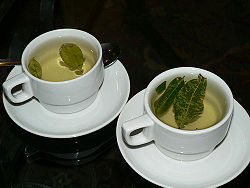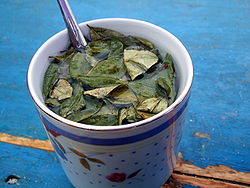
Coca tea
Encyclopedia

Tisane
A herbal tea, tisane, or ptisan is a herbal or plant infusion and usually not made from the leaves of the tea bush . Typically, herbal tea is simply the combination of boiling water and dried fruits, flowers or herbs. Herbal tea has been imbibed for nearly as long as written history extends...
(herbal tea) made using the leaves of the coca plant
Coca
Coca, Erythroxylum coca, is a plant in the family Erythroxylaceae, native to western South America. The plant plays a significant role in many traditional Andean cultures...
; typically the raw leaves of the plant. It is made either by submerging the coca leaf or dipping a tea bag
Tea bag
A tea bag is a small, porous sealed bag containing tea leaves and used for brewing tea. Tea bags are commonly made of paper, silk or plastic. The bag contains the tea leaves while the tea is brewed, making it easier to dispose of the leaves, and performs the same function as a tea infuser...
in hot water. The tea originates from the Andes
Andes
The Andes is the world's longest continental mountain range. It is a continual range of highlands along the western coast of South America. This range is about long, about to wide , and of an average height of about .Along its length, the Andes is split into several ranges, which are separated...
mountain range, particularly Bolivia
Bolivia
Bolivia officially known as Plurinational State of Bolivia , is a landlocked country in central South America. It is the poorest country in South America...
, Ecuador
Ecuador
Ecuador , officially the Republic of Ecuador is a representative democratic republic in South America, bordered by Colombia on the north, Peru on the east and south, and by the Pacific Ocean to the west. It is one of only two countries in South America, along with Chile, that do not have a border...
and Peru
Peru
Peru , officially the Republic of Peru , is a country in western South America. It is bordered on the north by Ecuador and Colombia, on the east by Brazil, on the southeast by Bolivia, on the south by Chile, and on the west by the Pacific Ocean....
.
The leaves of the coca plant contain several alkaloid
Alkaloid
Alkaloids are a group of naturally occurring chemical compounds that contain mostly basic nitrogen atoms. This group also includes some related compounds with neutral and even weakly acidic properties. Also some synthetic compounds of similar structure are attributed to alkaloids...
s including cocaine
Cocaine
Cocaine is a crystalline tropane alkaloid that is obtained from the leaves of the coca plant. The name comes from "coca" in addition to the alkaloid suffix -ine, forming cocaine. It is a stimulant of the central nervous system, an appetite suppressant, and a topical anesthetic...
; in fact, they comprise the sources for cocaine's chemical production, though the amount of cocaine in the leaves is so small, around 0.4%, that in order to make a gram of cocaine, 250 grams of coca leaves would be needed. A cup of coca tea prepared from one gram of coca leaves contains approximately 4.21 mg of cocaine.
Owing to the presence of the stimulant alkaloids, the coca tea provides a stimulant similar to coffee. The tea is often sold commercially in filtering bags, each of which usually contains approximately one gram of the leaf. As coffee can be decaffeinated, the coca tea can also be decocainized. Just like "decaf" coffee does retain a minute quantity of caffeine, "de-cocainated" coca tea will still contain a minute quantity of the drug. When the cocaine is removed, the amount of cocaine is small enough for the product to legally sell in the USA according to the Single Convention on Narcotic Drugs
Single Convention on Narcotic Drugs
The Single Convention on Narcotic Drugs of 1961 is an international treaty to prohibit production and supply of specific drugs and of drugs with similar effects except under licence for specific purposes, such as medical treatment and research...
. In the 1980s the tea was used to wean cocaine addicts off the drug.
The coca plant comprises four main species and varieties of Erythroxylum coca (often spelled koka in Quechua
Quechua languages
Quechua is a Native South American language family and dialect cluster spoken primarily in the Andes of South America, derived from an original common ancestor language, Proto-Quechua. It is the most widely spoken language family of the indigenous peoples of the Americas, with a total of probably...
and Aymara
Aymara language
Aymara is an Aymaran language spoken by the Aymara people of the Andes. It is one of only a handful of Native American languages with over three million speakers. Aymara, along with Quechua and Spanish, is an official language of Peru and Bolivia...
), a plant in the family
Family (biology)
In biological classification, family is* a taxonomic rank. Other well-known ranks are life, domain, kingdom, phylum, class, order, genus, and species, with family fitting between order and genus. As for the other well-known ranks, there is the option of an immediately lower rank, indicated by the...
Erythroxylaceae
Erythroxylaceae
The Erythroxylaceae is a family of flowering plants consisting of 4 genera and approximately 240 species. The best-known species is the coca plant , the source of the drug cocaine....
, native to northwestern South America.
Though also known as mate, mate de coca has very little in common with the mate
Mate (beverage)
Mate , also known as chimarrão or cimarrón, is a traditional South American infused drink, particularly in Argentina, Uruguay, Paraguay, southern states of Brazil, south of Chile, the Bolivian Chaco, and to some extent, Syria and Lebanon...
of yerba mate
Yerba mate
Maté, yerba maté or erva maté , Ilex paraguariensis, is a species of holly native to subtropical South America in northeastern Argentina, Bolivia, southern Brazil, Uruguay and Paraguay...
drink in Uruguay and Argentina. Mate de coca is always drunk as a tea, rather than through a straw.
Classification and nomenclature

Coca
Coca, Erythroxylum coca, is a plant in the family Erythroxylaceae, native to western South America. The plant plays a significant role in many traditional Andean cultures...
plant, which has the biological name Erythroxylum coca and is from the family Erythroxylaceae. It is often called "la Hoja de Coca" (the leaf of coca).
Characteristics
Coca Tea is a natural product. The tea preserves all of the physical-chemical properties of the coca leaf. The product fulfills the Technical Bolivian and Peruvian Standards and can be sold nationally, although such use is being discouraged in part by the Single Convention on Narcotic DrugsSingle Convention on Narcotic Drugs
The Single Convention on Narcotic Drugs of 1961 is an international treaty to prohibit production and supply of specific drugs and of drugs with similar effects except under licence for specific purposes, such as medical treatment and research...
.
The tea is greenish yellow in color and has a mild bitter flavor similar to green tea with a more organic sweetness.
Medicinal Use
Coca tea consumption is common in many South American countries. Many indigenous people of the AndesAndes
The Andes is the world's longest continental mountain range. It is a continual range of highlands along the western coast of South America. This range is about long, about to wide , and of an average height of about .Along its length, the Andes is split into several ranges, which are separated...
mountain range also use the tea for medicinal and religious purposes.
Tourism
On the "Inca Trail" to Machu PicchuMachu Picchu
Machu Picchu is a pre-Columbian 15th-century Inca site located above sea level. It is situated on a mountain ridge above the Urubamba Valley in Peru, which is northwest of Cusco and through which the Urubamba River flows. Most archaeologists believe that Machu Picchu was built as an estate for...
, guides usually serve coca tea with every meal because it is widely believed to alleviate the symptoms of altitude sickness
Altitude sickness
Altitude sickness—also known as acute mountain sickness , altitude illness, hypobaropathy, or soroche—is a pathological effect of high altitude on humans, caused by acute exposure to low partial pressure of oxygen at high altitude...
.
Most domestic flights to mountainous regions, such as Cusco, offer Coca tea during the flight to help the traveller adapt to the altitude. Coca tea is often recommended for people arriving to high altitude regions.
Traditionally, official governmental persons traveling to La Paz
La Paz
Nuestra Señora de La Paz is the administrative capital of Bolivia, as well as the departmental capital of the La Paz Department, and the second largest city in the country after Santa Cruz de la Sierra...
in Bolivia
Bolivia
Bolivia officially known as Plurinational State of Bolivia , is a landlocked country in central South America. It is the poorest country in South America...
, located at almost 4,000 meters above mean sea level
Above mean sea level
The term above mean sea level refers to the elevation or altitude of any object, relative to the average sea level datum. AMSL is used extensively in radio by engineers to determine the coverage area a station will be able to reach...
, are greeted with a mate de coca. News reports noted that Princess Anne
Anne, Princess Royal
Princess Anne, Princess Royal , is the only daughter of Elizabeth II and Prince Philip, Duke of Edinburgh...
and the late Pope John Paul II were served the beverage during their visits to the country.
See further
- Coca eradicationCoca eradicationCoca eradication is a controversial strategy strongly promoted by the United States government starting in 1961 as part of its "War on Drugs" to eliminate the cultivation of coca, a plant whose leaves are not only traditionally used by indigenous cultures but also, in modern society, in the...
- Coca-ColaCoca-ColaCoca-Cola is a carbonated soft drink sold in stores, restaurants, and vending machines in more than 200 countries. It is produced by The Coca-Cola Company of Atlanta, Georgia, and is often referred to simply as Coke...
, an international soft drink which now contains no cocaine - Coca CollaCoca CollaCoca Colla is an energy drink which is produced in Bolivia with the use of coca extract as its base. It was launched on the Bolivian market in La Paz, Santa Cruz and Cochabamba in mid-April 2010. Not only are the name and ingredients similar to Coca-Cola, but the colors and logo are of a similar...
, a similar Bolivian drink but which still contains Coca - Huallaga ValleyHuallaga ValleyThe Huallaga Valley is located in northern Peru, south of Tarapoto. It follows the Huallaga River.-Coca:Since the 1980s, the primary coca growing and drug trafficking activities in Peru have been in the Upper Huallaga Valley...
- Mate (beverage)Mate (beverage)Mate , also known as chimarrão or cimarrón, is a traditional South American infused drink, particularly in Argentina, Uruguay, Paraguay, southern states of Brazil, south of Chile, the Bolivian Chaco, and to some extent, Syria and Lebanon...
External links
- The Coca Museum (A private museum in La Paz, Bolivia)
- Coca - Cocaine website of the Transnational Institute (TNI)
- Coca leaf news page - Alcohol and Drugs History SocietyAlcohol and Drugs History SocietyThe Alcohol and Drugs History Society is a scholarly organization whose members study the history of a variety of illegal, regulated, and unregulated drugs such as opium, alcohol, and coffee. Organized in 2004, the ADHS is the successor to a society with a more limited scope, the Alcohol and...

